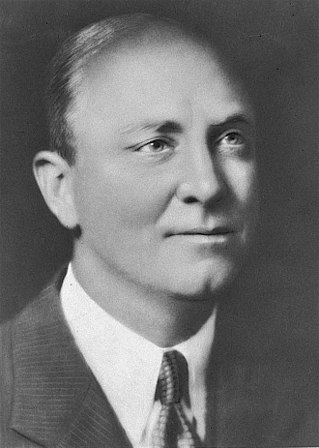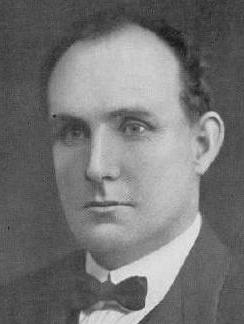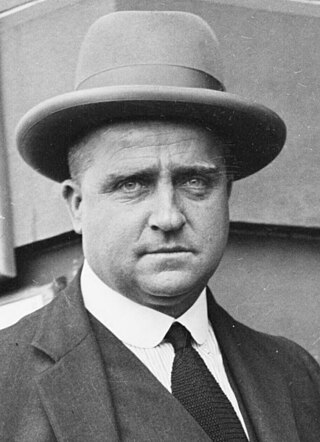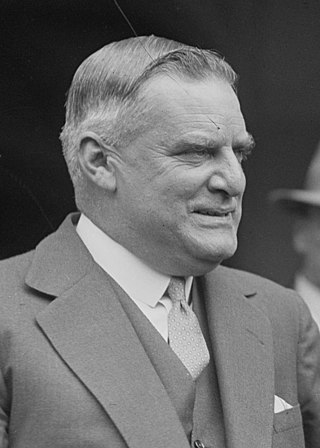
The United Australia Party (UAP) was an Australian political party that was founded in 1931 and dissolved in 1945. The party won four federal elections in that time, usually governing in coalition with the Country Party. It provided two prime ministers: Joseph Lyons (1932–1939) and Robert Menzies (1939–1941).

The Nationalist Party, also known as the National Party, was an Australian political party. It was formed in February 1917 from a merger between the Liberal Party and the National Labor Party, the latter formed by Prime Minister Billy Hughes and his supporters after the 1916 Labor Party split over World War I conscription. The Nationalist Party was established as a 'united' non-Labor opposition that had remained a political trend once the Labor party established itself in federal politics. The party was in government until electoral defeat in 1929. From that time it was the main opposition to the Labor Party until it merged with pro-Joseph Lyons Labor defectors to form the United Australia Party (UAP) in 1931. The party is a direct ancestor of the Liberal Party of Australia, the main centre-right party in Australia.

The Australian Party was a political party founded and led by Billy Hughes after his expulsion from the Nationalist Party. The party was formed in 1929, and at its peak had four members of federal parliament. It was merged into the new United Australia Party in 1931, having never contested a federal election.

Alexander Mair was an Australian politician who served as Premier of New South Wales from 5 August 1939 to 16 May 1941. Born in Melbourne, Mair worked in various businesses there before moving to Albury, New South Wales where he went on to be a member of the New South Wales Legislative Assembly for fourteen years. In 1932, Mair was elected to the seat of Albury and was re-elected a further four times. He rose quickly through the cabinet of Bertram Stevens' United Australia Party government, becoming an Assistant Minister in April 1938, Minister for Labour and Industry in June and Colonial Treasurer in October.

Reginald Walter Darcy Weaver was an Australian conservative parliamentarian who served in the New South Wales Legislative Assembly for 28 years. Serving from 1917 in the backbenches, he entered the cabinet of Thomas Bavin in 1929 as Secretary for Mines and Minister for Forests until he returned to opposition in 1930. Following the success of the United Australia Party in the 1932 election, Weaver returned as the Secretary for Public Works and Minister for Health in the Stevens ministry.

The 1931 Australian federal election was held on 19 December 1931. All 75 seats in the House of Representatives and 18 of the 36 seats in the Senate were up for election.

Lieutenant Colonel Sir Michael Frederick Bruxner was an Australian politician and soldier, serving for many years as leader of the Country Party in New South Wales. Born in the north of the state, Bruxner was educated at The Armidale School and started studies at University of Sydney but later dropped out to take up employment as a grazier and station agent in Tenterfield. After serving in the Citizen Military Forces from 1911, Bruxner enlisted into the Australian Light Horse upon the outbreak of the First World War in 1914. Serving with distinction in Gallipoli, Egypt and Palestine, he was promoted to lieutenant colonel and awarded the Distinguished Service Order.

John Arthur Perkins was an Australian newsagent, bookseller and politician. He was a member of the Australian House of Representatives from 1926 to 1943, representing the seat of Eden-Monaro for the Nationalist Party of Australia and its successor the United Australia Party. He was a minister in the governments of Joseph Lyons and Robert Menzies.

Sir Robert Archdale "Archie" ParkhillKCMG was an Australian politician who served in the House of Representatives from 1927 to 1937. He began his career in politics as a campaign director for the Commonwealth Liberal Party and Nationalist Party. He later joined the new United Australia Party in 1931, and served as a minister in the Lyons government between 1932 and 1937.
The Liberal Democratic Party (LDP) was an Australian breakaway political party of the United Australia Party that contested the 1943 federal election and the 1944 New South Wales state election. Formed in 1943, it was replaced by the New South Wales division of the Liberal Party of Australia in January 1945.

Thomas James Lavelle was an Australian politician. He was an Australian Labor Party member of the Australian House of Representatives from 1919 to 1922, representing the electorate of Calare.

John Dunlop Millen was an Australian engineer and politician. He served as a Senator for Tasmania from 1920 to 1938, representing the Nationalist Party until 1931 and then the United Australia Party (UAP). He managed the Mount Bischoff tin mine before entering politics and served a term as president of the Institution of Engineers, Australia.
This is a list of members of the Australian Senate from 1929 to 1932. Half of its members were elected at the 14 November 1925 election and had terms starting on 1 July 1926 and finishing on 30 June 1932; the other half were elected at the 17 November 1928 election and had terms starting on 1 July 1929 and finishing on 30 June 1935. The process for filling casual vacancies was complex. While senators were elected for a six-year term, people appointed to a casual vacancy only held office until the earlier of the next election for the House of Representatives or the Senate.

The 1932 New South Wales state election was held on 11 June 1932. This election was for all of the 90 seats in the 30th New South Wales Legislative Assembly and it was conducted in single member constituencies with compulsory preferential voting. It was a landslide victory for the UAP/Country Party coalition of Bertram Stevens, which had a majority of 42 in the Assembly.

Sir Vernon Haddon Treatt was an Australian lawyer, soldier, Rhodes Scholar and politician. Born in Singleton, New South Wales and educated at Shore School, Treatt interrupted his studies at the University of Sydney to enlist at the outbreak of the First World War. Serving in the Royal Australian Artillery, Treatt served in France and was awarded the Military Medal. Upon returning to Australia he was awarded a Rhodes scholarship and further educated at New College, Oxford.
Harrie Robert Croft Mitchell was an Australian politician and a member of the New South Wales Legislative Assembly for a single term between 1938 and 1941. He was a member of the United Australia Party

John Daniel FitzGerald was a politician, union official, journalist and barrister in New South Wales, Australia.
The Australian Labor Party split of 1931 was caused by severe divisions within the Australian Labor Party (ALP) over its economic response to the Great Depression. Amidst intense disagreement between economically conservative and radical elements of the party, two senior ministers in the Scullin Labor government, Joseph Lyons and James Fenton, resigned from Cabinet in January 1931. Lyons, Fenton and their supporters would subsequently merge with the conservative opposition Nationalist Party to form the new United Australia Party (UAP), led by Lyons with the last Nationalist leader, John Latham, as his deputy.

Sir Sydney Snow was an Australian businessman and political figure. His obituary in The Canberra Times described him as "one of Australia's greatest political, business and sporting figures".
The 1917 Macquarie state by-election was held for the New South Wales state electoral district of Macquarie on 28 July 1917. The by-election was triggered by the death of Australian Labor Party MP Thomas Thrower, who had died only three months after being re-elected at the 1917 state election.















